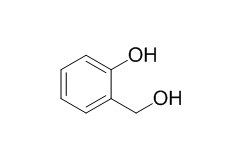Salicyl alcohol
Benzyl and salicyl alcohol, the local anesthetics, are effective inhibitors of lymphocyte-mediated cytolysis (LMC) in vitro.
Inquire / Order:
manager@chemfaces.com
Technical Inquiries:
service@chemfaces.com
Tel:
+86-27-84237783
Fax:
+86-27-84254680
Address:
1 Building, No. 83, CheCheng Rd., Wuhan Economic and Technological Development Zone, Wuhan, Hubei 430056, PRC
Providing storage is as stated on the product vial and the vial is kept tightly sealed, the product can be stored for up to
24 months(2-8C).
Wherever possible, you should prepare and use solutions on the same day. However, if you need to make up stock solutions in advance, we recommend that you store the solution as aliquots in tightly sealed vials at -20C. Generally, these will be useable for up to two weeks. Before use, and prior to opening the vial we recommend that you allow your product to equilibrate to room temperature for at least 1 hour.
Need more advice on solubility, usage and handling? Please email to: service@chemfaces.com
The packaging of the product may have turned upside down during transportation, resulting in the natural compounds adhering to the neck or cap of the vial. take the vial out of its packaging and gently shake to let the compounds fall to the bottom of the vial. for liquid products, centrifuge at 200-500 RPM to gather the liquid at the bottom of the vial. try to avoid loss or contamination during handling.
Nutrients.2023, 15(13):2960.
Nutrients.2020, 12(3):595.
J Chromatogr A.2017, 1518:46-58
Int J Mol Sci.2021, 22(16):8604.
Biol Pharm Bull.2018, 41(11):1645-1651
Food Chem.2018, 262:78-85
J Ethnopharmacol.2021, 267:113615.
Universiti Tunku Aboul Rahman2023, 6263.
Int J Mol Sci.2024, 25(20):11227.
Molecules.2022, 27(7):2116.
Related and Featured Products
European Journal of Immunology ,2010 ,3 (11) :674-7.
Inhibition of lymphocyte-mediated cytolysis by the local anesthetics benzyl and salicyl alcohol[Reference:
WebLink]
The local anesthetics, benzyl and Salicyl alcohol, are effective inhibitors of lymphocyte-mediated cytolysis (LMC) in vitro.
METHODS AND RESULTS:
LMC is not inhibited when the cytotoxic lymphocytes or target cells are preincubated in drug concentrations which are inhibitory if present during the reaction. Analysis of the cytolytic reaction has indicated that the inhibition of LMC is due to an interference with the interaction of lymphocytes and target cells, rather than suppression of the lytic phase of the reaction. Investigation of the effect on LMC of a number of different compounds with local anesthetic properties has shown that they inhibit LMC when present in similar concentrations to those known to block nerve impulse conduction.
CONCLUSIONS:
It is suggested that reversible cell membrane disorganization produced by these substances is the means whereby LMC is inhibited.
Naunyn Schmiedebergs Arch Pharmacol. 2014 Mar;387(3):281-90.
Synthetically modified bioisosteres of salicyl alcohol and their gastroulcerogenic assessment versus aspirin: biochemical and histological correlates.[Pubmed:
24292286]
The present study was conducted to synthesize nitrogen containing derivatives of Salicyl alcohol and to investigate in vivo their ulcerogenic potential in comparison with aspirin in rats.
METHODS AND RESULTS:
The compounds [4-(2-hydroxybenzyl) morpholin-4-iumchloride (I)] and [1,4-bis(2-hydroxybenzyl) piperazine-1,4-diium chloride (II)] were synthesized and their chemical structures were characterized using spectral data. In our previous study (Ali et al., Afr J Pharm Pharmacol 7:585-596, 2013), both compounds showed anti-inflammatory, antinociceptive, and antipyretic properties in standard animal models and a greater binding affinity for cyclooxygenase-2 versus cyclooxygenase-1 in molecular docking and dynamics analysis. For in vivo studies, animals were randomly divided into four groups. The synthetic compounds (both at 100 or 150 mg/kg), aspirin (150 mg/kg), or saline vehicle was administered orally, once daily for 6 days and then tested for ulcerogenic activity. At the end of the procedure, gastric juice and tissues were collected and subjected to biochemical and histological analyses. The results of the study revealed that in the case of the aspirin-treated group, there was a significant increase in gastric juice volume, free acidity, total acidity, and ulcer score and a decrease in gastric pH. Moreover, histological examination of the gastric mucosa of the aspirin-treated group indicated morphological changes while neither of the synthetic compounds showed any significant ulcerogenic or cytotoxic properties.
CONCLUSIONS:
The results of the present study suggest that both compounds are free from ulcerogenic side effects and may represent a better alternative to aspirin.
Arch Pharm Res. 2014 Jul;37(7):916-26.
Comparative evaluation of gastroulcerogenic potential of nitrogen isoforms of salicyl alcohol and aspirin in rats: biochemical and histological study.[Pubmed:
24085627]
The aim of the current study was to explore in vivo any relative gastroulcerogenic prospective propensity of newly synthesized nitrogen containing derivatives of Salicyl alcohol; compound (I) [1-(2-hydroxybenzyl)piperidinium chloride], compound (II) [4-carbamoyl-1-(2-hydroxybenzyl)piperidinium chloride] and aspirin in albino rats.
METHODS AND RESULTS:
The experimental groups received the following oral treatments daily for 6 days: group I saline control; group II, standard (aspirin) treatment group [150 mg/kg of body weight]; group III, test (compound I) treatment group [100, 150 mg/kg]; group IV, test (compound II) treatment group [100, 150 mg/kg]. The results showed that in the case of the aspirin treated group and compound (I) [150 mg/kg], there was a significant increase in gastric volume, free acidity, total acidity, ulcer score and a decrease in gastric pH. Furthermore, histopathological examination of gastric mucosa of these treated groups revealed detectable morphological changes. Utilizing the same protocol, synthetic compound (I) [100 mg/kg] and (II) [100, 150 mg/kg] exhibited no statistically significant ulcerogenic or cytotoxic properties. A cyclooxygenase (COX) selectivity test indicated the preferential inhibition of COX-I and COX-II enzymes by compounds (I) and (II).
CONCLUSIONS:
This study therefore indicates that these synthetic compounds may possess reduced ulcerogenic potential and could be a functional substitute to aspirin.



